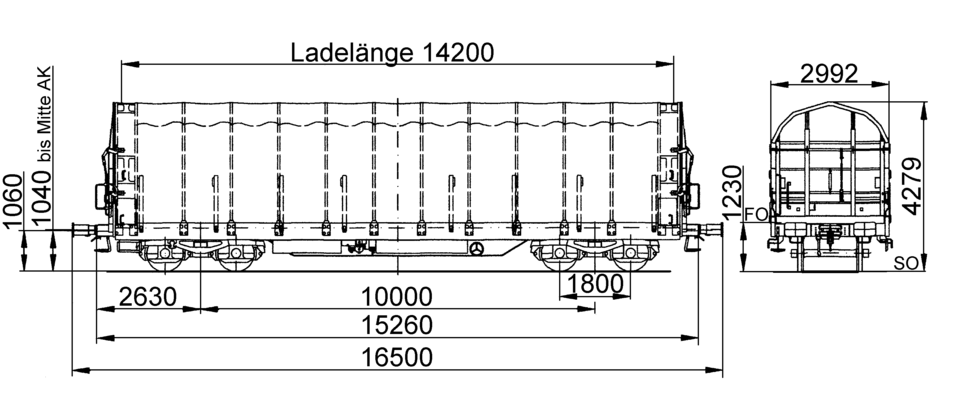Article: Rijmmns 660
Bogie flat wagon with four wheelsets, with sliding tarpaulin cover and with stanchions.These bogie flat wagons are particularly suitable for transporting moisture-sensitive goods due to the tarpaulin cover. Its special features also include a shock absorber device to protect the goods from shunting impacts.
Technical details
Loading length (mm) | 14,200 |
Loading width (mm) | 2,750 (between the edge bars) |
Loading height (mm) | 2,300 |
Loading area (m2) | 39.0 |
Average tare weight (kg) | 27,460 |
Maximum speed (km/h) | 120 |
International usability | RIV |
Smallest radius of curvature (m) | 35 |
First year of delivery or year of construction of the oldest wagons at this time | 2002 |
Parking brake | With and without parking brake |
Number of brake cylinders (pcs.) | 1 |
Brake cylinder diameter (mm) | 406 |
Type of load-proportional braking | Automatic, independent, pneumatic |
Buffer type | UIC 526-1, Category A with MINER spring 40 kJ |
Buffer head dimensions (mm) | 450 x 340 |
Automatic coupler | Prepared |
Brake type | KE-GP-A |
Distributor valve type | KE 2dSL-ALB/d8 |
Individual data
Stanchion height (mm) | 1,200 |
Load limits
Tare weight > 27.0 t ≤ 27.5 t
With and without parking brake
A | B | C | D | ||
|---|---|---|---|---|---|
S | 36.5 t | 44.5 t | 52.5 t | 62.5 t | |
120 |
DB | CM |
|---|---|
100 | 56.5 t |
Concentrated loads
m | Spread over the support length | On two baseplates | |
|---|---|---|---|
a-a | 2 | 32.0 | 33.0 |
b-b | 5 | 39.0 | 44.0 |
c-c | 8 | 42.0 | 52.0 |
d-d | 11 | 62.5 | 62.5 |
e-e | 14 | 62.5 | --- |
Additional information:
The wagon is covered with a PVC-coated fabric tarpaulin, which rests on 14 tubular frames. The tarpaulin roof is guided in the longitudinal direction of the wagon via smooth-running carriages and sliding tracks on the underframe and can be moved up to a maximum opening width of 11 m. The tarpaulin roof is locked to the end walls by means of a four-point central locking system that can be operated both from the ground and from the platform. In order to ensure better utilisation of the loading space, the roof bow construction is equipped with an additional spreader. The wagon may only be moved with the tarpaulin roof closed and locked.
In the loading space, eight folding and adjustable side stanchions made of fine-grained structural steel with a height of 1,200 mm as well as seven retractable and adjustable guide rails made of structural steel with a height of 30 mm are provided for securing the load in the transverse direction on each long side of the wagon. Both the side stanchions and the guide rails are guided in recesses in the floor and are adjustable at intervals of 50 mm. When not in use, the side stanchions can be lowered into external storage recesses and the guide rails into internal storage recesses to achieve a level loading area.
In addition, there are 14 lashing rings per wagon side in the 20 mm high edge bars.The load is secured in the longitudinal direction by a hydraulic long-stroke shock absorber with 350 mm stroke, which limits the acceleration of the cargo to a maximum of 1 g when loaded with at least half the load limit and at impact speeds of up to 9 km/h. The non-nailable wagon floor is made from multi-ply wooden panels and can withstand wheel loads of up to 30 kN.
The underframe consists of side solebars, inner solebars, crossbearers and the front-end components with end walls. In the central area of the underframe, the movable, divisible sliding element is guided in a cut-out together with the headstocks and the buffing and draw gear. The sliding element is guided in the underframe with little play in the transverse direction of the wagon; force is only transmitted in the longitudinal direction of the wagon via the long-stroke shock absorber.
The underframe, the end walls and the sliding element are a welded structure made from sheet metal, wide steel, strip steel, rolled and folded sections mainly in the S355 steel grade. Fine-grained S460N structural steel is used for parts of the underframe that are subject to especially high loads.
The wagon is fitted with lifting and jacking points on the side solebars in the area of the bogies.
All data provided without any guarantee of correctness or completeness.
